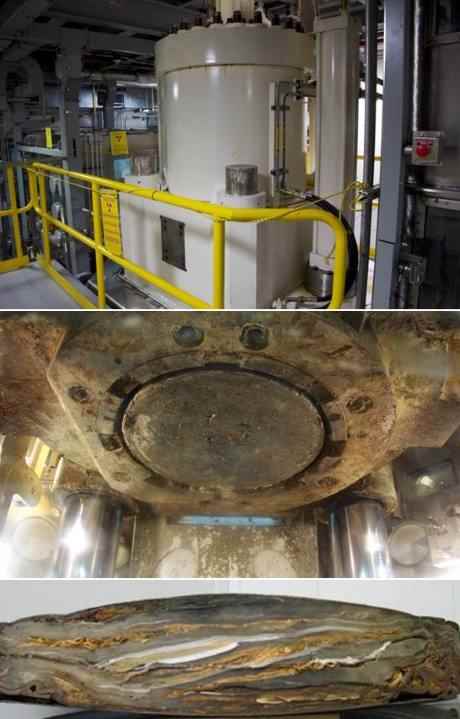A unique piece of equipment that can compress a 55-gallon (200-litre) waste drum to a fifth of its original size has achieved 100,000 hours of operation at the US Department of Energy's (DOE) Idaho site. Compacting has reduced the number of shipments of transuranic waste from the Advanced Mixed Waste Treatment Project (AMWTP) for disposal in New Mexico.
 |
| The supercompactor, from top to bottom: The hydraulic housing located on top of the supercompactor; the 'business end' of the compactor, that pushes down on drums filled with contaminated materials; the 'puck' produced by the compaction of a 55-gallon drum (Images: DOE-Fluor Idaho) |
The supercompactor's hydraulic ram exerts four million pounds (1800 tonnes) of force, reducing a drum filled with solid waste to a "puck" 5-7 inches (13-18cm) thick. It has compacted more than 238,000 drums of waste debris during the past 14 years, enabling the AMWTP to save an estimated 6000 truck shipments that would have been needed to send nearly 43,000 cubic metres of waste to the Waste Isolation Pilot Plant (WIPP). Supercompaction also enables disposal space at the New Mexico facility - the USA's only permanent repository for transuraniuc waste - to be used more efficiently.
Jack Zimmerman, deputy manager of the DOE's Idaho Operations Office, said compacting drums allowed for a greater return on investment for each waste shipment sent from Idaho to WIPP. "The supercompactor has paid for itself many times over considering the valuable space it has saved at WIPP and the number of truck shipments it has saved the taxpayer," he said.
The DOE's Idaho site, 45 miles west of Idaho Falls, houses legacy wastes from World War II- and Cold War-era conventional weapons testing, government-owned research and power reactor development and testing, used nuclear fuel reprocessing, laboratory research, and defence missions, including wastes shipped from other sites. Most of the site's transuranic wastes - industrial debris contaminated with transuranic elements, especially plutonium - were shipped from the DOE's now-closed Rocky Flats plant near Denver which manufactured military components.
Operations at the AMWTP, which has recently undergone equipment upgrades to position it for future operations, centre on the retrieval, characterisation, treatment and packaging of transuranic waste currently stored the Idaho site. Fluor Idaho LLC has managed the Idaho Cleanup Project Core since June 2016 under a five-year contract.
Researched and written
by World Nuclear News




_18570.jpg)
_16159.jpg)
_18938.jpg)
_33584.jpg)





